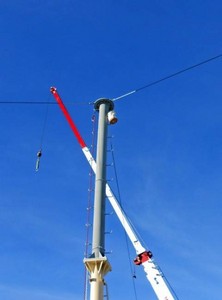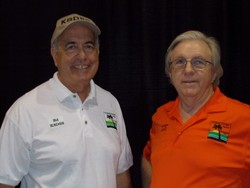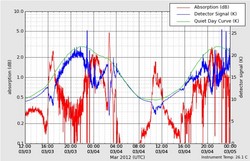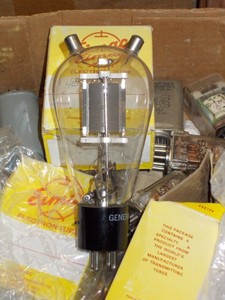 January 2, 2013 Editor: Ward Silver, NØAX | ||||||
IN THIS ISSUE
NEW HF OPERATORS - THINGS TO DO If you've never operated on Kid's Day, you are missing something delightful. Open up your shack to a family member or invite the neighbor kids over - watch for the looks of surprise and delight as they make a contact or two. If you don't have a kid of your own, get on and be the station that creates those happy moments. You won't regret it! BULLETINS There are no bulletins in this issue which is a bit attenuated due to the editor's vacation. BUSTED QSOS The RAC Winter Contest and the Stew Perry Top Band Distance Challenge contest listings were accidentally omitted from the previous issue - apologies to the sponsors. CONTEST SUMMARY Complete information for all contests follows the Conversation section Jan 5-6
Jan 12-13
Just how old is the car radio, anyway? The story involves one of the largest mobile radio companies and a famous name in invention lore. (Thanks, Wayne ABØGR)
Much has been made of the everybody-on-the-same-frequency problem after a spot is posted. Win-Test and N1MM have frequency offset or randomizing functions so that when you click on a spot, your frequency is offset by + or - 100 Hz. QNZ! Ten-Tec has announced the latest model of an old friend - the Argonaut. The 539 Argonaut VI continues the QRP tradition at Ten-Tec, where the original "Argo" was one of its early successes. The rig features the same high dynamic range receiver architecture as the recently-introduced Eagle transceiver, 1-10 watts of output power on the HF bands, and a simple user interface. Martti OH2BH contributes this handy world-wide temperature conversion table: +15 °C, Spanish wear caps, gloves and winter coats, Finns are sunbathing
Just how big were those legendary stations of yore? Well, pretty big! Tim K3LR credits this article in the September 1982 edition of Scuttlebutt, the Yankee Clipper Contest Club's newsletter, as an inspiration to creating the world-class station he's built today. You might not think hum and background noise could ever be an asset but this BBC article reports that they are being used as a means of determining the source of recordings and whether they have been tampered with. The latest issue (2/2012) of PileUP! is now out. PileUP! is the PDF newsletter of Contest Club Finland. This issue fills 47 pages in Finnish (Google Translate can handle the translation) and English. (Thanks, Timo OH1NOA) WORD TO THE WISE Whinge - a terrific word from our British Commonwealth friends, roughly equivalent to "whine" here in America. Your New Year's resolution? No whinging, mate! Alan, W2AEW has assembled a nice collection of "how to" videos on YouTube on using oscilloscopes. (Thanks, Paul W9AC) If you're musically inclined, watching this video of Vadrum hammering out the alphabet might be an excellent way to learn the code! (Thanks, Tim K3LR) The results of the ARRL 10 GHz and Up Contest are now live and all RTTY Roundup certificates and plaques have been mailed. (Thanks, ARRL Contest Branch Manager, Sean KX9X) The volunteers who hand-enter all of the paper Sweepstakes logs into electronic Cabrillo format files report that 67 paper logs were typed in. That includes 27 CW and 40 phone logs with 3999 CW QSOs (average just over 148 QSOs per log) and 6105 phone QSOs (average 152.625 QSOs per log). Thanks to one and all! Now - let's all do our part and help anyone hand-logging submit their logs electronically, such as by using WA7BNM's Cabrillo Web Forms page. The CWJF Group is proud to publish CQMM DX Contest 2012 Results online. (Thanks, Luc PT7AG) OPERATING TIP A reader asks, "I thought leaving duplicate QSOs ("dupes") in a log was a problem - no?" In paper logs, dupes used to be a problem because they were hard for the log checkers to detect and remove. Thus, there was a penalty to the station submitting the log for leaving them in. (The station worked was not penalized...) In electronic logs, it's easy for the log checking software to identify and discard dupes. Not only that, leaving the dupes in an electronic log makes it possible to insure everybody gets credit for a QSO since an initial contact may not have been completed or mis-logged in some way. The duplicate QSO may, in fact, be the valid QSO, especially if the duping station called you! If you think about it the way Trey N5KO recommended in the latest National Contest Journal, it will make more sense. "In the days of paper logs there was a claimed score, and then there would be deductions made for miscopied call signs and so forth. With 100 percent log checking by machine, the old approach gave way to a new methodology, where your log starts at zero points, and your score builds with each contact and multiplier as your log is evaluated." So there is no reason to penalize dupes - the worst thing that can happen is that your score isn't increased. So definitely leave the dupes in your electronic log - you won't be penalized. While we're on the subject, send in your log - many a certificate is hanging on the wall of those who persevered all the way through log submission while their competition got lazy or just plain forgot! Dave W8NF recalls that "professional" TV shops used home-made workbenches, made of wood. "The bench height was 42 inches. This allowed the techs to stand at the bench, a more healthy position than sitting all day. But it also afforded an added layer of shock protection. When first placing a piece of equipment on the bench for testing, we sat down - on 32" tall wooden bar stools. Rest your feet on the cross-member about a foot off the floor, and there's no risk at all of a shock traveling through the body."
If you find it hard to keep edges straight when trimming PC board, this jig design from Instructables uses inexpensive materials and also protects fingertips! Tony G3OVH reports, "The differences between the RF and computing worlds get even smaller with this article showing how you can transmit 100 MHz FM from a Raspberry Pi single-board computer." And even smaller as this primer on software defined radio explains. (Thanks, Brian N9ADG and George K5TR) Charles, KG2V relayed this mnemonic for remembering the color order of CAT5 network cable: blue, orange, green, brown - remember "sky to ground" - blue sky, orange sun, green grass, brown earth. Brian N9ADG has discovered, "If you type "4.7k ohm" into the search bar of duckduckgo.com, you get the color code representation of a resistor."
If you are looking for conductive lubricants, Jerry KF6VB contributes the CAIG Laboratories web site. "Every conductive grease and oil that a child could want." And with the post-holiday sale season upon us, who could resist? Technical Web Site of the Week - Here's a great application note from Jameco on those "wall wart" power supplies - the different types and their characteristics. This will help you choose the right supply for your application. (Thanks, Dan KI4YZE) Making FM Contesting Succeed The ARRL January VHF Contest offers an FM-Only category for the first time. The goal is, of course, to encourage new hams that have never used the "weak signal" modes to do a bit of DXing and find out what their stations are capable of. Contests are a terrific way to do just that but communicating with the target audience requires understanding their needs and expectations. Les Rayburn N1LF posted a thoughtful discussion on this topic to the VHFcontesting reflector - it is food for thought for all of us who participate in both emcomm and radiosport. Thanks, Les. 73, Ward NØAX As the previous Section Emergency Coordinator for Alabama, I understood that FM simplex capability translated to a greater level of capability during an emergency. Amateurs who improved their stations on simplex, also benefited by being able to reach more distant repeaters which is a huge advantage during severe weather.
Some "lessons learned" from cross-promoting FM activity during VHF+ contests were: 2 Jan through 15 Jan 2013 An expanded, downloadable version of QST's Contest Corral in PDF format is available. Check the sponsor's Web site for information on operating time restrictions and other instructions. HF CONTESTS ARRL RTTY Roundup--Digital, from Jan 5, 1800Z to Jan 6, 2400Z. Bands (MHz): 3.5-28. Exchange: RST, state/province/serial. Logs due: Feb 7. Rules Kid's Day--Phone, from Jan 6, 1800Z to Jan 6, 2400Z. Bands (MHz): 3.5-28. Exchange: Name, age, location, favorite color. Rules North American QSO Party--CW, from Jan 12, 1800Z to Jan 13, 0600Z. Bands (MHz): 1.8-28. Exchange: Name and S/P/C. Logs due: 14 days. Rules SNS and NS Weekly Sprints--CW, from Jan 4, 0200Z to Jan 4, 0300Z. Weekly on Thursday evenings local time. Bands (MHz): 1.8-14. Exchange: Serial, name, and S/P/C. Logs due: 2 days. Rules 070 PSKFest--Digital, from Jan 5, 0000Z to Jan 5, 2400Z. Bands (MHz): 3.5-28. Exchange: Call sign, RST, S/P/C . Logs due: Jan 19. Rules QRP Pet Rock Sprint--CW, from Jan 5, 1500Z to Jan 5, 1800Z. Bands (MHz): 3.5-28. Frequencies (MHz): QRP calling frequencies. Exchange: RST, S/P/C, QRP ARCI number or power. Logs due: 14 days. Rules OK1WC Memorial Contest--Phone,CW, from Jan 7, 1600Z to Jan 7, 1659Z. First through fourth Monday of each month; see website for bands. Bands (MHz): 3.5, 50, 144. Exchange: RS(T) and serial. Logs due: 7 days. Rules ARS Spartan Sprint--CW, from Jan 8, 0200Z to Jan 8, 0400Z. Monthly on the first Monday evening local time. Bands (MHz): 3.5-28. Exchange: RST, S/P/C, and power. Logs due: 2 days. Rules CWops Monthly Mini-CWT Test--CW, from Jan 9, 1300Z to Jan 9, 1400Z. Multiple operating periods, twice monthly on 2nd and 4th Wed. Bands (MHz): 1.8-28. Frequencies (MHz): 18 to 28 kHz above band edge. Exchange: Name and member number or S/P/C. Logs due: 2 days. Rules MI QRP Club Jan QRP Contest--CW, from Jan 12, 1200Z to Jan 13, 2359Z. Bands (MHz): 1.8-28, 50. Exchange: RST, S/P/C, MI QRP number or power. Logs due: Feb 13. Rules WW Peace Messenger Cities--Phone,CW, from Jan 12, 1200Z to Jan 13, 1200Z. Bands (MHz): 3.5-28. Exchange: RS(T) and PMC ref number or CQ zone. Logs due: 30 days. Rules UK DX RTTY Contest--Digital, from Jan 12, 1200Z to Jan 13, 1200Z. Bands (MHz): 3.5-28. Exchange: RST and serial. Logs due: 30 days. Rules EUCW 160 Meter Contest--CW, from Jan 12, 2000Z to Jan 12, 2300Z. Multiple operating periods. Bands (MHz): 1.8. Frequencies (MHz): Exchange: RST, serial, club name, member nr or "NR". Logs due: Feb 13. Rules DARC 10 Meter Contest--Phone,CW, from Jan 13, 0900Z to Jan 13, 1059Z. Bands (MHz): 28. Exchange: RS(T), serial, DOK code. Logs due: 2 weeks. Rules VHF+ CONTESTS OK1WC Memorial Contest--Phone,CW, from Jan 7, 1600Z to Jan 7, 1659Z. First through fourth Monday of each month; see website for bands. Bands (MHz): 3.5, 50, 144. Exchange: RS(T) and serial. Logs due: 7 days. Rules MI QRP Club Jan QRP Contest--CW, from Jan 12, 1200Z to Jan 13, 2359Z. Bands (MHz): 1.8-28, 50. Exchange: RST, S/P/C, MI QRP number or power. Logs due: Feb 13. Rules LOG DUE DATES 2 Jan through 15 Jan 2013
ARRL Information Click here to advertise in this newsletter, space subject to availability. Your One-Stop Resource for Amateur Radio News and Information ARRL membership includes QST, Amateur Radio's most popular and informative journal, delivered to your mailbox each month. Subscribe to NCJ - the National Contest Journal. Published bimonthly, features articles by top contesters, letters, hints, statistics, scores, NA Sprint and QSO Parties. Subscribe to QEX - A Forum for Communications Experimenters. Published bimonthly, features technical articles, construction projects, columns and other items of interest to radio amateurs and communications professionals. Free of charge to ARRL members: Subscribe to The ARRL Letter (weekly digest of news and information), the ARES E-Letter (monthly public service and emergency communications news), Division and Section news -- and much more! ARRL offers a wide array of products to enhance your enjoyment of Amateur Radio. Visit the site often for new publications, specials and sales. Donate to the fund of your choice -- support programs not funded by member dues! Reprint permission can be obtained by sending email to permission@arrl.org with a description of the material and the reprint publication. ACKNOWLEDGEMENTS ARRL Contest Update wishes to acknowledge information from WA7BNM's Contest Calendar and SM3CER's Contest Calendar. | ||||||











